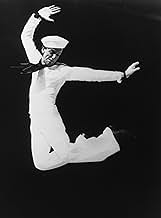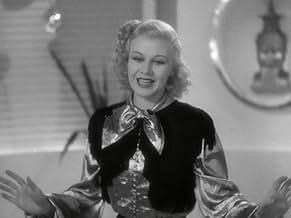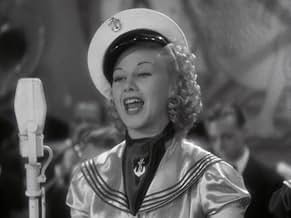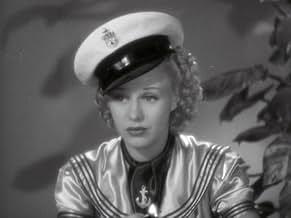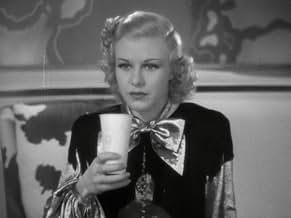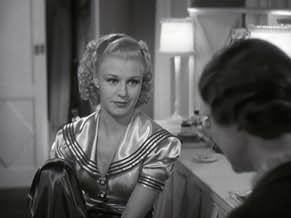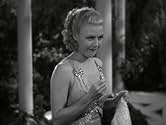AVALIAÇÃO DA IMDb
7,1/10
4,9 mil
SUA AVALIAÇÃO
Adicionar um enredo no seu idiomaA Navy sailor tries to rekindle a romance with the woman he loves while on liberty in San Francisco.A Navy sailor tries to rekindle a romance with the woman he loves while on liberty in San Francisco.A Navy sailor tries to rekindle a romance with the woman he loves while on liberty in San Francisco.
- Direção
- Roteiristas
- Artistas
- Prêmios
- 4 vitórias e 2 indicações no total
Harriet Nelson
- Connie Martin
- (as Harriet Hilliard)
Jean Acker
- Minor Role
- (não creditado)
Richard Alexander
- Paradise Ballroom Waiter
- (não creditado)
Constance Bergen
- Ticket Seller
- (não creditado)
Frederic Blanchard
- Captain Jones
- (não creditado)
Lynton Brent
- Deck Officer
- (não creditado)
Phyllis Brooks
- Minor Role
- (não creditado)
Tom Brower
- Policeman
- (não creditado)
Avaliações em destaque
One of several musicals about sailors on leave, it is the usual sailor meets girl, complications ensue, sorted out happily kind of plot. It proceeds along smoothly enough but it does drag in places too. The dialogue is not as zippy as 'Top Hat' for example and Randolph Scott seems out of place.
There are compensations. It has some of Irving Berlin's choicest songs including 'Let Yourself Go', 'I'm Putting all My Eggs in One Basket' and 'Let's Face the Music and Dance'. It has Fred and Ginger who when they are dancing take any film into heavenly heights and they don't disappoint here. They do a snappy tap dance, a knockabout comic dance and a swirling graceful dance, all in the same film! Great versatility and artistry.
It also has Harriet Hilliard who is rather good in her role. She had a varied career, becoming the more famous Harriet Nelson with Ozzie. Here she is touching without being sentimental.Her two songs are simply and effectively delivered. She makes a good contrast with Ginger but you can believe they are sisters in the film.
More tightening up have made the film even better. Pretty good though.
There are compensations. It has some of Irving Berlin's choicest songs including 'Let Yourself Go', 'I'm Putting all My Eggs in One Basket' and 'Let's Face the Music and Dance'. It has Fred and Ginger who when they are dancing take any film into heavenly heights and they don't disappoint here. They do a snappy tap dance, a knockabout comic dance and a swirling graceful dance, all in the same film! Great versatility and artistry.
It also has Harriet Hilliard who is rather good in her role. She had a varied career, becoming the more famous Harriet Nelson with Ozzie. Here she is touching without being sentimental.Her two songs are simply and effectively delivered. She makes a good contrast with Ginger but you can believe they are sisters in the film.
More tightening up have made the film even better. Pretty good though.
This film is nice because there are two love stories-- something of a plot departure, and the second couple (Randolph Scott and Harriet Hilliard Nelson) are given the bulk of the dramatics, which allow our stars to be looser, more comical. Astaire chews the gum a little too severely, but he was anxious to make a departure from his customary tuxedoed playboy. Rogers is much more at ease in the role of struggling dancer-singer, and plays well opposite sister Hilliard. (The history is that Ms. Hilliard had to darken her naturally blond hair to distinguish her from Ms. Rogers. But wouldn't they better resemble sisters if they were both blonds?) The Irving Berlin numbers are quite good, ranging from light and airy ("Let Yourself Go," "I'd Rather Lead A Band") to elegant ("Let's Face The Music And Dance"). This final number is the film's bewitching finale, performed on a lovely Art-Deco rooftop and illustrates Astaire's penchant for full-frame, single-take dancing. It is, in a nutshell, singularly gorgeous. The trivia history goes that Rogers' metallic thread gown had weights in the sleeves and hem to make the skirt wind and unwind; the dress was unintentionally difficult to perform in because its flared sleeves hit Astaire across the face IN THE FIRST TAKE- and after many re-shoots trying to cover it up, they ended up printing that first take (we have to assume that was apparently the best performance of the dance, but you can see the sleeves brush across Astaire's face). It loses one-half point from me, because Randolph Scott says 'bebby' once too often.
This is my all-time favorite Fred Astaire and Ginger Rogers film. The dialogue between the two is so cute and funny and very clever. Not to mention this film contains some of the best songs recorded by the two; like I'm Putting All My Eggs in One Basket and Let's Face the Music and Dance. If I remember correctly, this was the film that introduced me to Fred Astaire so I suppose because of that it will always hold a special place in my heart (sorry for the sentimental cr*p but I'm woman so get over it)All in all this film gets an 8/10 from me. The choreography was superb and also the fact that Lucille Ball is in it makes it even more awesome.
One of the best of the Fred Astaire and Giner Rogers films. Great music by Irving Berlin. Solid support from Randolph Scott, Harriet Nelson, Lucille Ball, Betty Grable, Frank Jenks, and Astrid Allwyn.
Terrific songs include "Let Yourself Go," "Let's Face the Music," and "Putting All My Eggs in One Basket." The last song is introduced by Astaire playing a jazzy piano and then a cute dance with Rogers. Rogers also sings "Let Yourself Go" with Grable among the backup singers.
Harriet Nelson (then Hilliard) sings two nice songs and plays Rogers' mousy sister. "Get Thee Behind Me" is a song that sticks with you for days. She also sings "But Where Are You?" Snappy and fast paced, this entry in the Astaire-Rogers series is one of the better ones. The classic and amazing beautiful finale, "Let's Face the Music and Dance" is among the best-known of their numbers. Rogers wears one of the great dresses in movie history.... a shimmering sequined number that swirls around her legs as she dances (weighted hem) and is also slightly see through. Just gorgeous. This is the number that Steve Martin and Bernadette Peters re-created in Pennies from Heaven.
Randolph Scott seems an odd choice as Astaire's pal but he also appeared in their Roberta with Irene Dunne. Luckily he does not attempt to sing or dance. It seems that Grable and Ball would have had bigger parts in 1936 but they have a few scenes and make little impact. Allwyn has the bigger role but is only OK.
Rogers has one of her best solo numbers in the series with "Let Yourself Go".... Jazzy and thumping, it's a great song.
Fun all the way, although I got tired of "We Joined the Navy" after the third time....
Terrific songs include "Let Yourself Go," "Let's Face the Music," and "Putting All My Eggs in One Basket." The last song is introduced by Astaire playing a jazzy piano and then a cute dance with Rogers. Rogers also sings "Let Yourself Go" with Grable among the backup singers.
Harriet Nelson (then Hilliard) sings two nice songs and plays Rogers' mousy sister. "Get Thee Behind Me" is a song that sticks with you for days. She also sings "But Where Are You?" Snappy and fast paced, this entry in the Astaire-Rogers series is one of the better ones. The classic and amazing beautiful finale, "Let's Face the Music and Dance" is among the best-known of their numbers. Rogers wears one of the great dresses in movie history.... a shimmering sequined number that swirls around her legs as she dances (weighted hem) and is also slightly see through. Just gorgeous. This is the number that Steve Martin and Bernadette Peters re-created in Pennies from Heaven.
Randolph Scott seems an odd choice as Astaire's pal but he also appeared in their Roberta with Irene Dunne. Luckily he does not attempt to sing or dance. It seems that Grable and Ball would have had bigger parts in 1936 but they have a few scenes and make little impact. Allwyn has the bigger role but is only OK.
Rogers has one of her best solo numbers in the series with "Let Yourself Go".... Jazzy and thumping, it's a great song.
Fun all the way, although I got tired of "We Joined the Navy" after the third time....
This is just a great, fun, lovely film. It captures the true essence of the decade and of the people, and tells a beautiful love story of two sisters with two sailors. Though this film may only be in Black and White, it definitely doesn't count against it now in modern days. The main basic purpose of the movie is timeless. This movie features great acting, beautiful song and dance numbers, and great design work and film shots. Follow the Fleet is also comical, there are funny moments, moments that will make you laugh, but other moments where the acting just gets you so involved into the storyline. Its amazing how though this movie may be set in a certain decade, how it can affect those today. If you want to see something great, check this out.
Você sabia?
- CuriosidadesDuring the fight scene between Fred Astaire and Randolph Scott, Astaire - not skilled in movie fight scenes - accidentally bloodied Scott's nose; Astaire was mortified, but Scott remained pointedly nonchalant.
- Citações
Sherry Martin: Look, why don't you let me try to fix you up? You'll be amazed how much better it will make you feel.
Connie Martin: Even though I'm not a blonde, I could be dumb, couldn't I?
Sherry Martin: And you'll probably do all right too. It takes a lot of brains to be dumb.
- ConexõesFeatured in Fred Astaire: Puttin' on His Top Hat (1980)
- Trilhas sonorasWe Saw the Sea
(uncredited)
Written by Irving Berlin
Played during the opening credits
Performed by Fred Astaire and chorus
[Also played as dance music]
Principais escolhas
Faça login para avaliar e ver a lista de recomendações personalizadas
- How long is Follow the Fleet?Fornecido pela Alexa
Detalhes
- Data de lançamento
- País de origem
- Idiomas
- Também conhecido como
- Follow the Fleet
- Locações de filme
- Empresa de produção
- Consulte mais créditos da empresa na IMDbPro
Bilheteria
- Orçamento
- US$ 747.000 (estimativa)
- Tempo de duração1 hora 50 minutos
- Cor
- Proporção
- 1.37 : 1
Contribua para esta página
Sugerir uma alteração ou adicionar conteúdo ausente

Principal brecha
By what name was Nas Águas da Esquadra (1936) officially released in India in English?
Responda

